Analysis and Recommendations: Melville City Crime Prevention Report
VerifiedAdded on 2023/01/11
|9
|2735
|85
Report
AI Summary
This report, prepared for the Melville City Council, addresses concerns about rising crime rates and offers a comprehensive analysis of crime prevention strategies. It begins with an introduction to crime prevention, defining it as efforts to reduce and deter crime, and then proceeds to outline a detailed crime prevention plan. The report explores the impact of anti-social behavior on crime, providing examples and highlighting its contribution to community concerns and increased crime rates. It then delves into various crime prevention theories, including environmental crime prevention, situational crime prevention (routine activity, crime pattern, and rational choice theories), and social crime prevention. The report also discusses community development and the need for government initiatives to reduce crime, such as stricter alcohol policies and focused policing. The conclusion emphasizes the importance of effective crime prevention programs to enhance the quality of life for all citizens and the need for ongoing evaluation and improvement. Finally, the report references relevant literature to support its findings and recommendations.
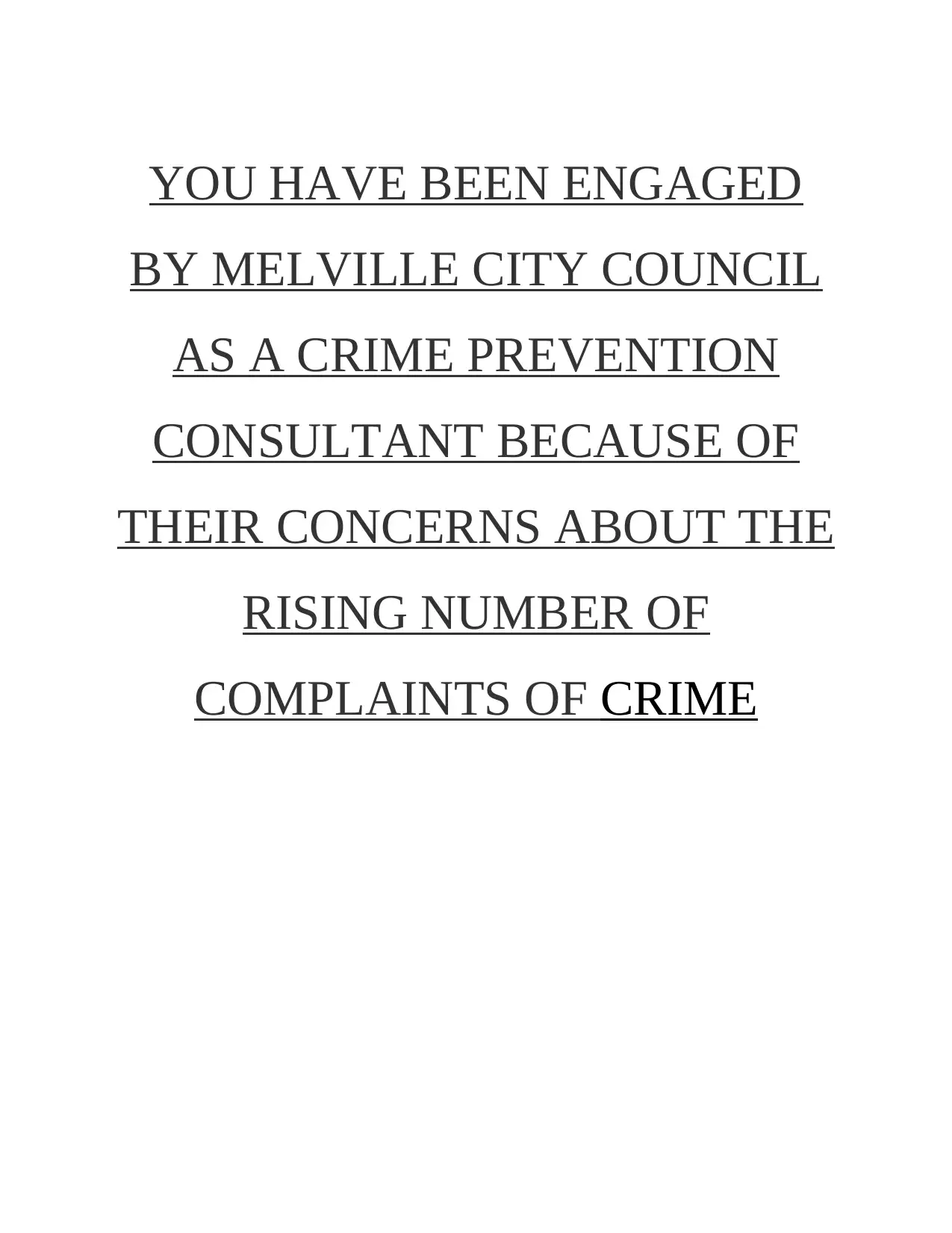
YOU HAVE BEEN ENGAGED
BY MELVILLE CITY COUNCIL
AS A CRIME PREVENTION
CONSULTANT BECAUSE OF
THEIR CONCERNS ABOUT THE
RISING NUMBER OF
COMPLAINTS OF CRIME
BY MELVILLE CITY COUNCIL
AS A CRIME PREVENTION
CONSULTANT BECAUSE OF
THEIR CONCERNS ABOUT THE
RISING NUMBER OF
COMPLAINTS OF CRIME
Paraphrase This Document
Need a fresh take? Get an instant paraphrase of this document with our AI Paraphraser
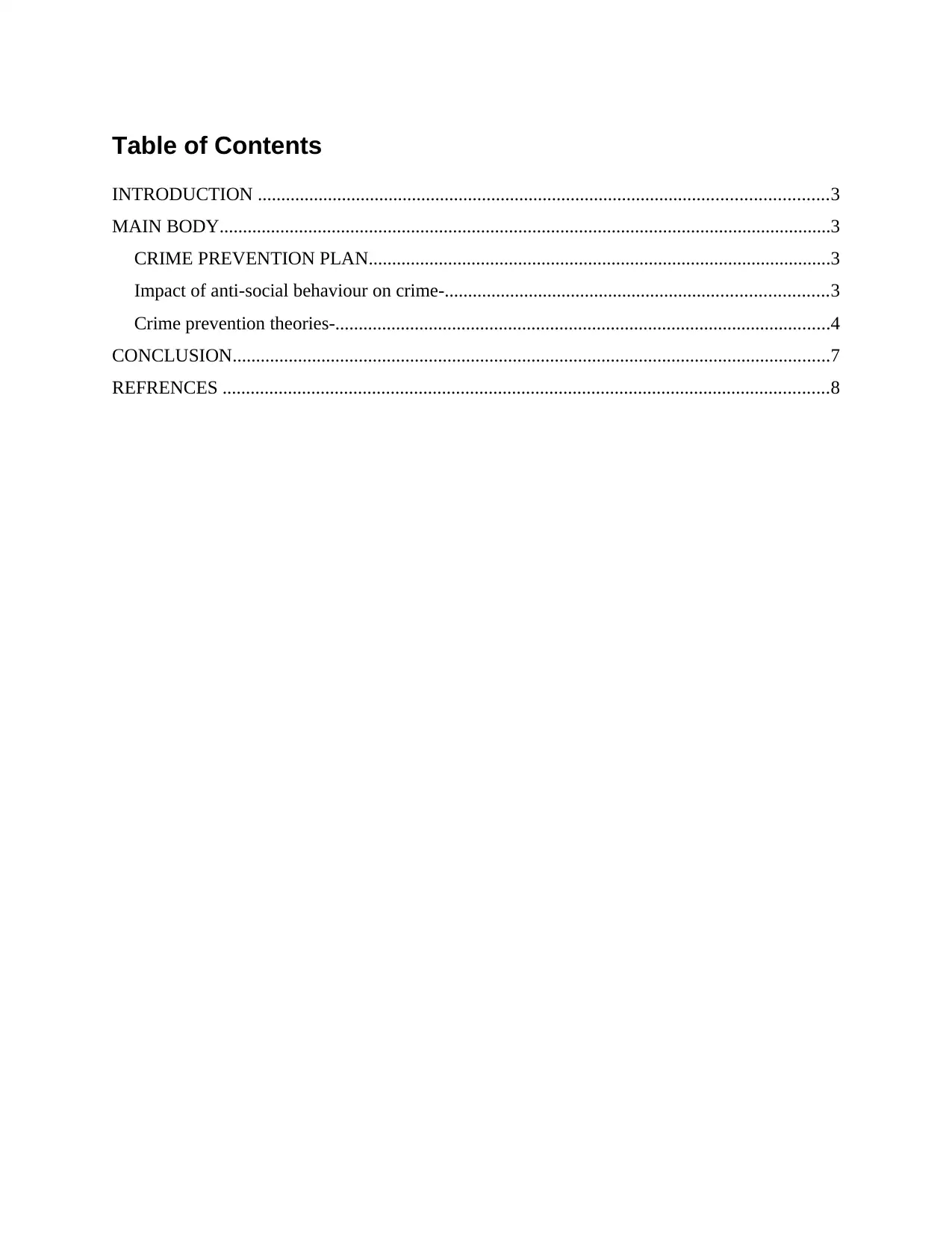
Table of Contents
INTRODUCTION ..........................................................................................................................3
MAIN BODY...................................................................................................................................3
CRIME PREVENTION PLAN...................................................................................................3
Impact of anti-social behaviour on crime-..................................................................................3
Crime prevention theories-..........................................................................................................4
CONCLUSION................................................................................................................................7
REFRENCES ..................................................................................................................................8
INTRODUCTION ..........................................................................................................................3
MAIN BODY...................................................................................................................................3
CRIME PREVENTION PLAN...................................................................................................3
Impact of anti-social behaviour on crime-..................................................................................3
Crime prevention theories-..........................................................................................................4
CONCLUSION................................................................................................................................7
REFRENCES ..................................................................................................................................8
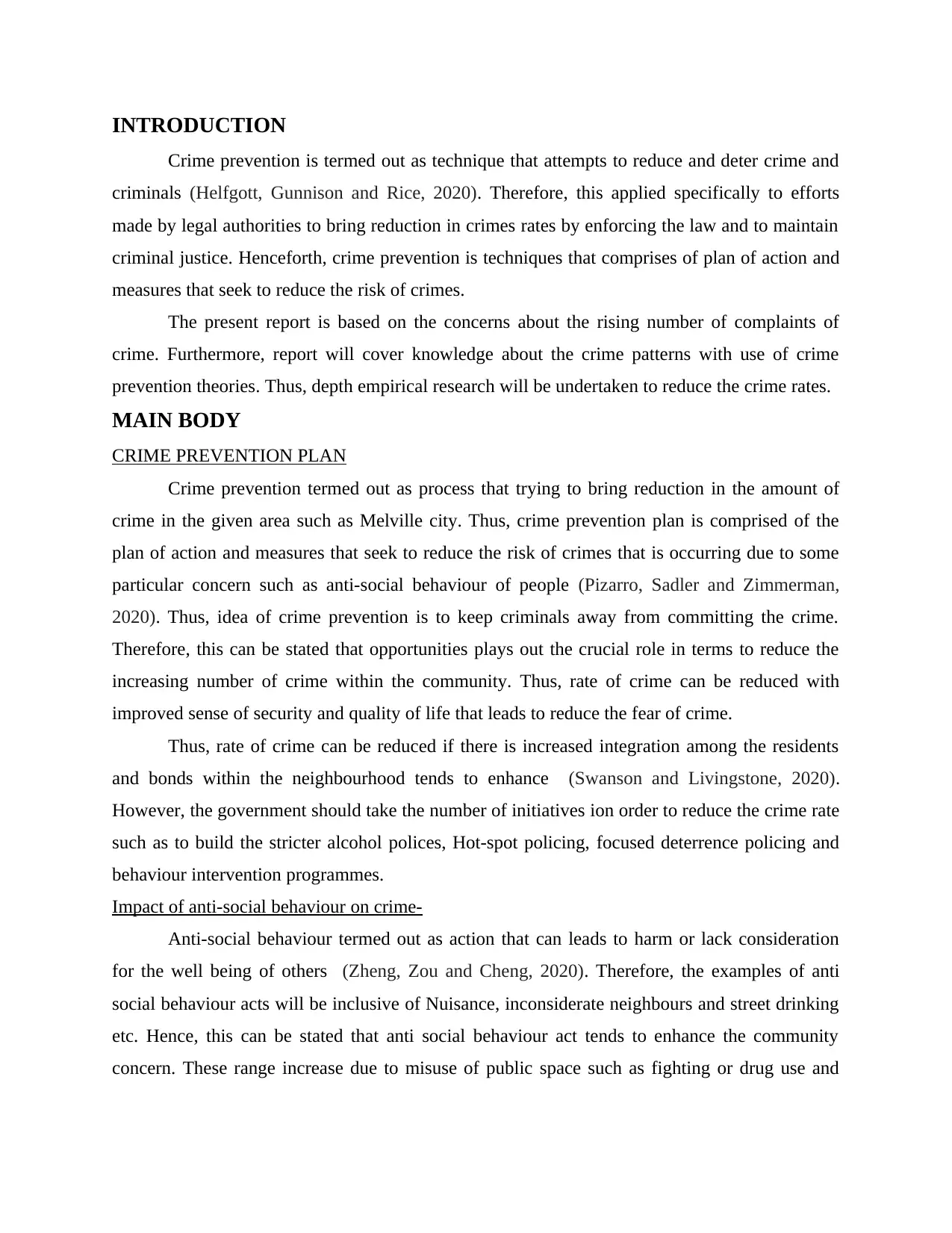
INTRODUCTION
Crime prevention is termed out as technique that attempts to reduce and deter crime and
criminals (Helfgott, Gunnison and Rice, 2020). Therefore, this applied specifically to efforts
made by legal authorities to bring reduction in crimes rates by enforcing the law and to maintain
criminal justice. Henceforth, crime prevention is techniques that comprises of plan of action and
measures that seek to reduce the risk of crimes.
The present report is based on the concerns about the rising number of complaints of
crime. Furthermore, report will cover knowledge about the crime patterns with use of crime
prevention theories. Thus, depth empirical research will be undertaken to reduce the crime rates.
MAIN BODY
CRIME PREVENTION PLAN
Crime prevention termed out as process that trying to bring reduction in the amount of
crime in the given area such as Melville city. Thus, crime prevention plan is comprised of the
plan of action and measures that seek to reduce the risk of crimes that is occurring due to some
particular concern such as anti-social behaviour of people (Pizarro, Sadler and Zimmerman,
2020). Thus, idea of crime prevention is to keep criminals away from committing the crime.
Therefore, this can be stated that opportunities plays out the crucial role in terms to reduce the
increasing number of crime within the community. Thus, rate of crime can be reduced with
improved sense of security and quality of life that leads to reduce the fear of crime.
Thus, rate of crime can be reduced if there is increased integration among the residents
and bonds within the neighbourhood tends to enhance (Swanson and Livingstone, 2020).
However, the government should take the number of initiatives ion order to reduce the crime rate
such as to build the stricter alcohol polices, Hot-spot policing, focused deterrence policing and
behaviour intervention programmes.
Impact of anti-social behaviour on crime-
Anti-social behaviour termed out as action that can leads to harm or lack consideration
for the well being of others (Zheng, Zou and Cheng, 2020). Therefore, the examples of anti
social behaviour acts will be inclusive of Nuisance, inconsiderate neighbours and street drinking
etc. Hence, this can be stated that anti social behaviour act tends to enhance the community
concern. These range increase due to misuse of public space such as fighting or drug use and
Crime prevention is termed out as technique that attempts to reduce and deter crime and
criminals (Helfgott, Gunnison and Rice, 2020). Therefore, this applied specifically to efforts
made by legal authorities to bring reduction in crimes rates by enforcing the law and to maintain
criminal justice. Henceforth, crime prevention is techniques that comprises of plan of action and
measures that seek to reduce the risk of crimes.
The present report is based on the concerns about the rising number of complaints of
crime. Furthermore, report will cover knowledge about the crime patterns with use of crime
prevention theories. Thus, depth empirical research will be undertaken to reduce the crime rates.
MAIN BODY
CRIME PREVENTION PLAN
Crime prevention termed out as process that trying to bring reduction in the amount of
crime in the given area such as Melville city. Thus, crime prevention plan is comprised of the
plan of action and measures that seek to reduce the risk of crimes that is occurring due to some
particular concern such as anti-social behaviour of people (Pizarro, Sadler and Zimmerman,
2020). Thus, idea of crime prevention is to keep criminals away from committing the crime.
Therefore, this can be stated that opportunities plays out the crucial role in terms to reduce the
increasing number of crime within the community. Thus, rate of crime can be reduced with
improved sense of security and quality of life that leads to reduce the fear of crime.
Thus, rate of crime can be reduced if there is increased integration among the residents
and bonds within the neighbourhood tends to enhance (Swanson and Livingstone, 2020).
However, the government should take the number of initiatives ion order to reduce the crime rate
such as to build the stricter alcohol polices, Hot-spot policing, focused deterrence policing and
behaviour intervention programmes.
Impact of anti-social behaviour on crime-
Anti-social behaviour termed out as action that can leads to harm or lack consideration
for the well being of others (Zheng, Zou and Cheng, 2020). Therefore, the examples of anti
social behaviour acts will be inclusive of Nuisance, inconsiderate neighbours and street drinking
etc. Hence, this can be stated that anti social behaviour act tends to enhance the community
concern. These range increase due to misuse of public space such as fighting or drug use and
⊘ This is a preview!⊘
Do you want full access?
Subscribe today to unlock all pages.

Trusted by 1+ million students worldwide
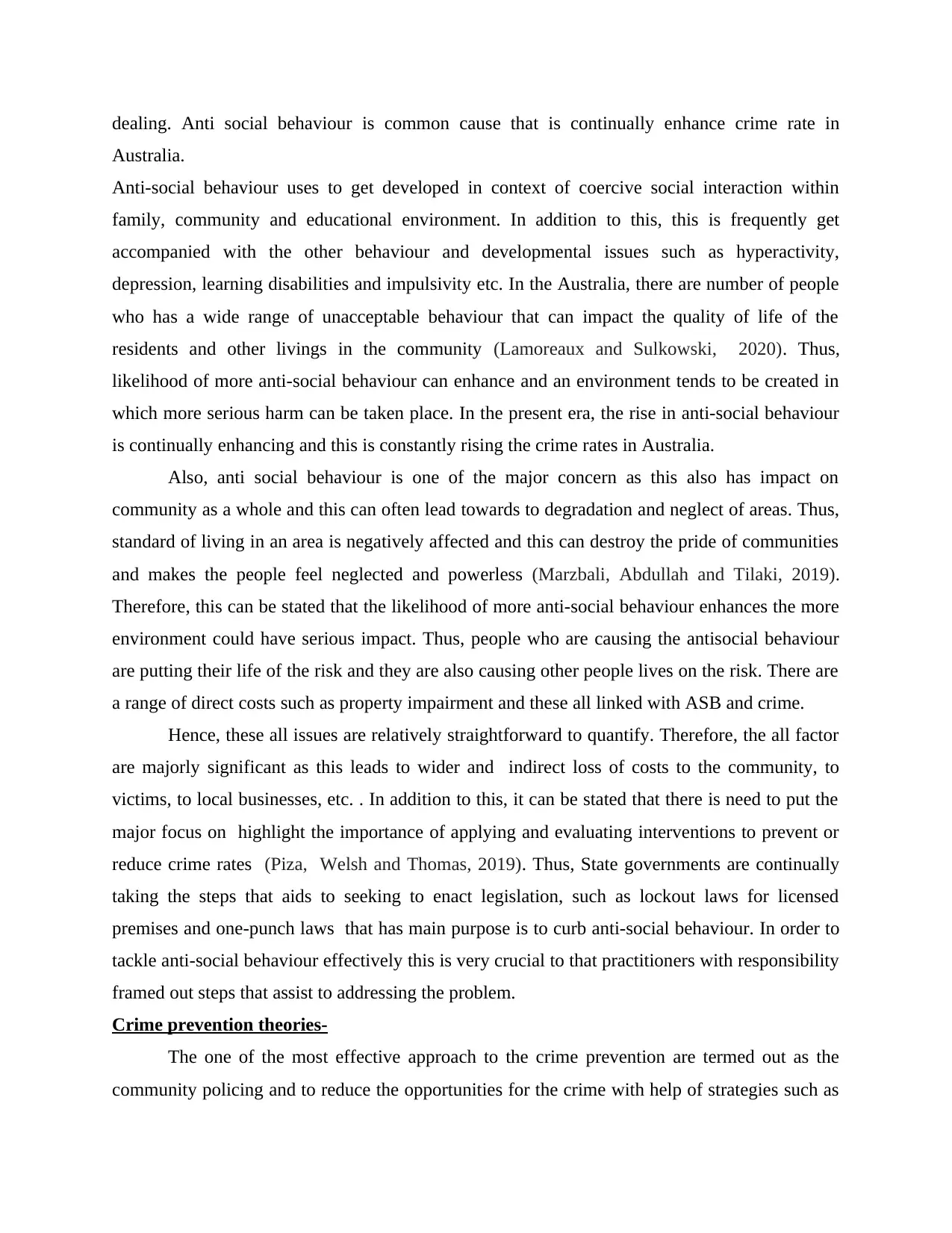
dealing. Anti social behaviour is common cause that is continually enhance crime rate in
Australia.
Anti-social behaviour uses to get developed in context of coercive social interaction within
family, community and educational environment. In addition to this, this is frequently get
accompanied with the other behaviour and developmental issues such as hyperactivity,
depression, learning disabilities and impulsivity etc. In the Australia, there are number of people
who has a wide range of unacceptable behaviour that can impact the quality of life of the
residents and other livings in the community (Lamoreaux and Sulkowski, 2020). Thus,
likelihood of more anti-social behaviour can enhance and an environment tends to be created in
which more serious harm can be taken place. In the present era, the rise in anti-social behaviour
is continually enhancing and this is constantly rising the crime rates in Australia.
Also, anti social behaviour is one of the major concern as this also has impact on
community as a whole and this can often lead towards to degradation and neglect of areas. Thus,
standard of living in an area is negatively affected and this can destroy the pride of communities
and makes the people feel neglected and powerless (Marzbali, Abdullah and Tilaki, 2019).
Therefore, this can be stated that the likelihood of more anti-social behaviour enhances the more
environment could have serious impact. Thus, people who are causing the antisocial behaviour
are putting their life of the risk and they are also causing other people lives on the risk. There are
a range of direct costs such as property impairment and these all linked with ASB and crime.
Hence, these all issues are relatively straightforward to quantify. Therefore, the all factor
are majorly significant as this leads to wider and indirect loss of costs to the community, to
victims, to local businesses, etc. . In addition to this, it can be stated that there is need to put the
major focus on highlight the importance of applying and evaluating interventions to prevent or
reduce crime rates (Piza, Welsh and Thomas, 2019). Thus, State governments are continually
taking the steps that aids to seeking to enact legislation, such as lockout laws for licensed
premises and one-punch laws that has main purpose is to curb anti-social behaviour. In order to
tackle anti-social behaviour effectively this is very crucial to that practitioners with responsibility
framed out steps that assist to addressing the problem.
Crime prevention theories-
The one of the most effective approach to the crime prevention are termed out as the
community policing and to reduce the opportunities for the crime with help of strategies such as
Australia.
Anti-social behaviour uses to get developed in context of coercive social interaction within
family, community and educational environment. In addition to this, this is frequently get
accompanied with the other behaviour and developmental issues such as hyperactivity,
depression, learning disabilities and impulsivity etc. In the Australia, there are number of people
who has a wide range of unacceptable behaviour that can impact the quality of life of the
residents and other livings in the community (Lamoreaux and Sulkowski, 2020). Thus,
likelihood of more anti-social behaviour can enhance and an environment tends to be created in
which more serious harm can be taken place. In the present era, the rise in anti-social behaviour
is continually enhancing and this is constantly rising the crime rates in Australia.
Also, anti social behaviour is one of the major concern as this also has impact on
community as a whole and this can often lead towards to degradation and neglect of areas. Thus,
standard of living in an area is negatively affected and this can destroy the pride of communities
and makes the people feel neglected and powerless (Marzbali, Abdullah and Tilaki, 2019).
Therefore, this can be stated that the likelihood of more anti-social behaviour enhances the more
environment could have serious impact. Thus, people who are causing the antisocial behaviour
are putting their life of the risk and they are also causing other people lives on the risk. There are
a range of direct costs such as property impairment and these all linked with ASB and crime.
Hence, these all issues are relatively straightforward to quantify. Therefore, the all factor
are majorly significant as this leads to wider and indirect loss of costs to the community, to
victims, to local businesses, etc. . In addition to this, it can be stated that there is need to put the
major focus on highlight the importance of applying and evaluating interventions to prevent or
reduce crime rates (Piza, Welsh and Thomas, 2019). Thus, State governments are continually
taking the steps that aids to seeking to enact legislation, such as lockout laws for licensed
premises and one-punch laws that has main purpose is to curb anti-social behaviour. In order to
tackle anti-social behaviour effectively this is very crucial to that practitioners with responsibility
framed out steps that assist to addressing the problem.
Crime prevention theories-
The one of the most effective approach to the crime prevention are termed out as the
community policing and to reduce the opportunities for the crime with help of strategies such as
Paraphrase This Document
Need a fresh take? Get an instant paraphrase of this document with our AI Paraphraser
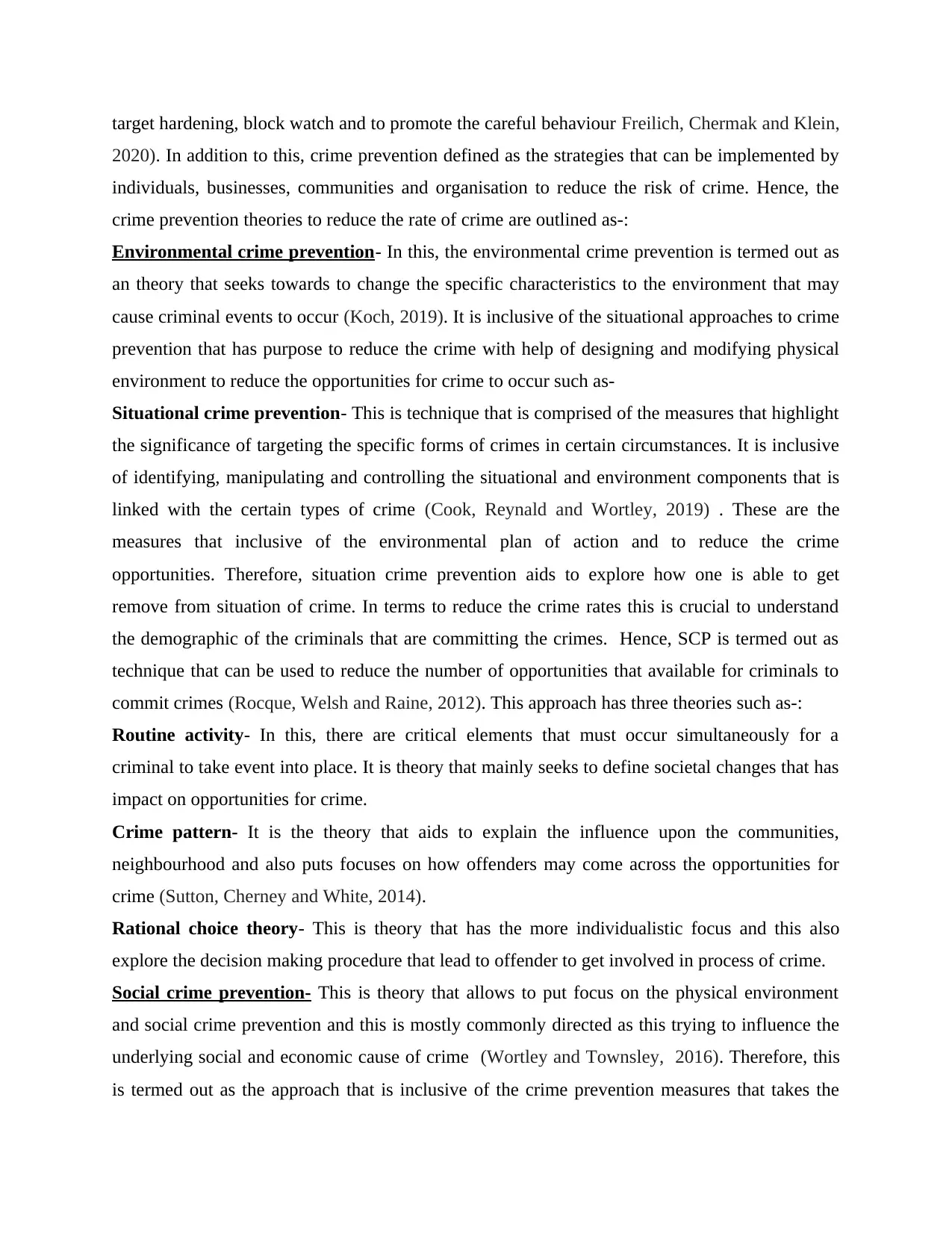
target hardening, block watch and to promote the careful behaviour Freilich, Chermak and Klein,
2020). In addition to this, crime prevention defined as the strategies that can be implemented by
individuals, businesses, communities and organisation to reduce the risk of crime. Hence, the
crime prevention theories to reduce the rate of crime are outlined as-:
Environmental crime prevention- In this, the environmental crime prevention is termed out as
an theory that seeks towards to change the specific characteristics to the environment that may
cause criminal events to occur (Koch, 2019). It is inclusive of the situational approaches to crime
prevention that has purpose to reduce the crime with help of designing and modifying physical
environment to reduce the opportunities for crime to occur such as-
Situational crime prevention- This is technique that is comprised of the measures that highlight
the significance of targeting the specific forms of crimes in certain circumstances. It is inclusive
of identifying, manipulating and controlling the situational and environment components that is
linked with the certain types of crime (Cook, Reynald and Wortley, 2019) . These are the
measures that inclusive of the environmental plan of action and to reduce the crime
opportunities. Therefore, situation crime prevention aids to explore how one is able to get
remove from situation of crime. In terms to reduce the crime rates this is crucial to understand
the demographic of the criminals that are committing the crimes. Hence, SCP is termed out as
technique that can be used to reduce the number of opportunities that available for criminals to
commit crimes (Rocque, Welsh and Raine, 2012). This approach has three theories such as-:
Routine activity- In this, there are critical elements that must occur simultaneously for a
criminal to take event into place. It is theory that mainly seeks to define societal changes that has
impact on opportunities for crime.
Crime pattern- It is the theory that aids to explain the influence upon the communities,
neighbourhood and also puts focuses on how offenders may come across the opportunities for
crime (Sutton, Cherney and White, 2014).
Rational choice theory- This is theory that has the more individualistic focus and this also
explore the decision making procedure that lead to offender to get involved in process of crime.
Social crime prevention- This is theory that allows to put focus on the physical environment
and social crime prevention and this is mostly commonly directed as this trying to influence the
underlying social and economic cause of crime (Wortley and Townsley, 2016). Therefore, this
is termed out as the approach that is inclusive of the crime prevention measures that takes the
2020). In addition to this, crime prevention defined as the strategies that can be implemented by
individuals, businesses, communities and organisation to reduce the risk of crime. Hence, the
crime prevention theories to reduce the rate of crime are outlined as-:
Environmental crime prevention- In this, the environmental crime prevention is termed out as
an theory that seeks towards to change the specific characteristics to the environment that may
cause criminal events to occur (Koch, 2019). It is inclusive of the situational approaches to crime
prevention that has purpose to reduce the crime with help of designing and modifying physical
environment to reduce the opportunities for crime to occur such as-
Situational crime prevention- This is technique that is comprised of the measures that highlight
the significance of targeting the specific forms of crimes in certain circumstances. It is inclusive
of identifying, manipulating and controlling the situational and environment components that is
linked with the certain types of crime (Cook, Reynald and Wortley, 2019) . These are the
measures that inclusive of the environmental plan of action and to reduce the crime
opportunities. Therefore, situation crime prevention aids to explore how one is able to get
remove from situation of crime. In terms to reduce the crime rates this is crucial to understand
the demographic of the criminals that are committing the crimes. Hence, SCP is termed out as
technique that can be used to reduce the number of opportunities that available for criminals to
commit crimes (Rocque, Welsh and Raine, 2012). This approach has three theories such as-:
Routine activity- In this, there are critical elements that must occur simultaneously for a
criminal to take event into place. It is theory that mainly seeks to define societal changes that has
impact on opportunities for crime.
Crime pattern- It is the theory that aids to explain the influence upon the communities,
neighbourhood and also puts focuses on how offenders may come across the opportunities for
crime (Sutton, Cherney and White, 2014).
Rational choice theory- This is theory that has the more individualistic focus and this also
explore the decision making procedure that lead to offender to get involved in process of crime.
Social crime prevention- This is theory that allows to put focus on the physical environment
and social crime prevention and this is mostly commonly directed as this trying to influence the
underlying social and economic cause of crime (Wortley and Townsley, 2016). Therefore, this
is termed out as the approach that is inclusive of the crime prevention measures that takes the
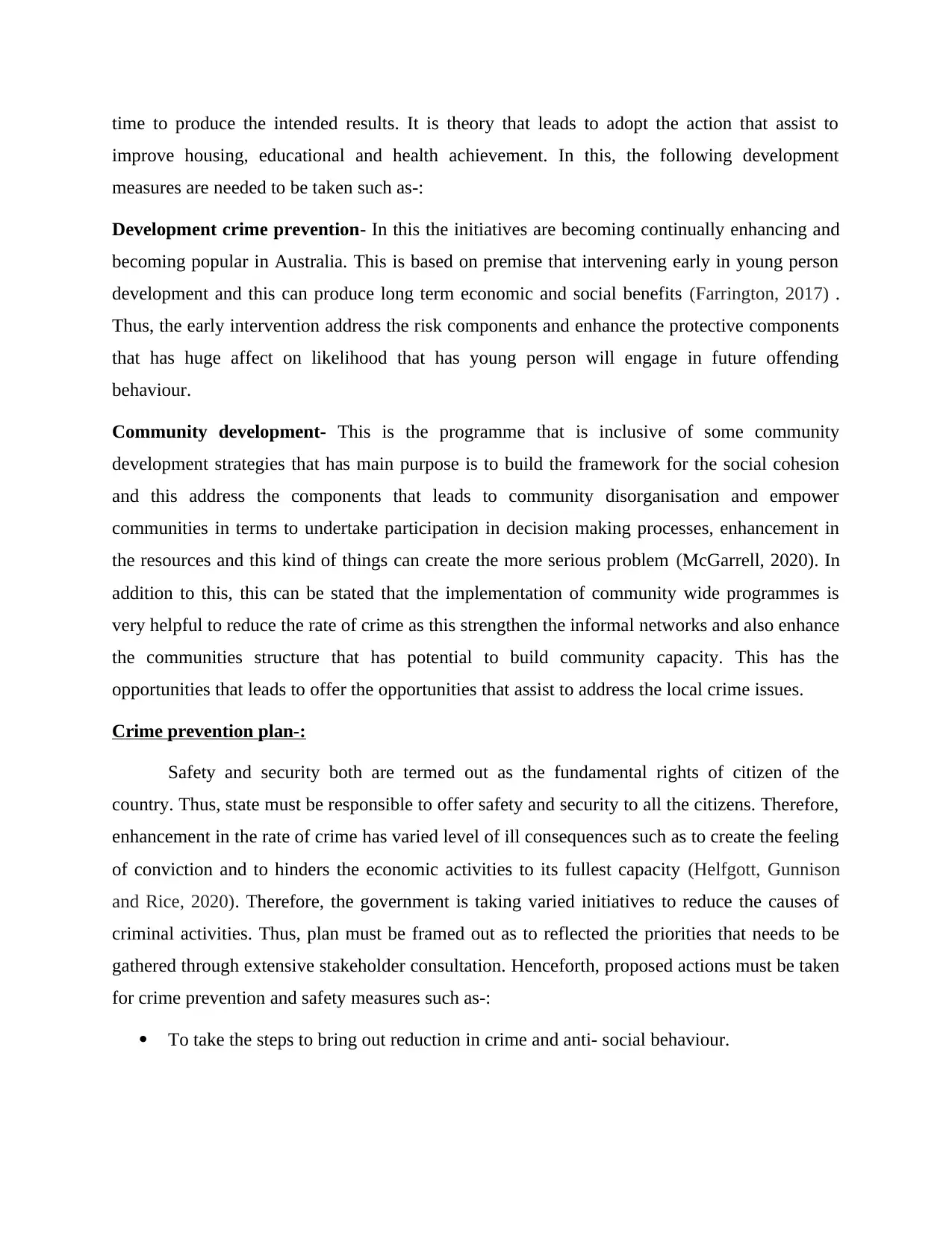
time to produce the intended results. It is theory that leads to adopt the action that assist to
improve housing, educational and health achievement. In this, the following development
measures are needed to be taken such as-:
Development crime prevention- In this the initiatives are becoming continually enhancing and
becoming popular in Australia. This is based on premise that intervening early in young person
development and this can produce long term economic and social benefits (Farrington, 2017) .
Thus, the early intervention address the risk components and enhance the protective components
that has huge affect on likelihood that has young person will engage in future offending
behaviour.
Community development- This is the programme that is inclusive of some community
development strategies that has main purpose is to build the framework for the social cohesion
and this address the components that leads to community disorganisation and empower
communities in terms to undertake participation in decision making processes, enhancement in
the resources and this kind of things can create the more serious problem (McGarrell, 2020). In
addition to this, this can be stated that the implementation of community wide programmes is
very helpful to reduce the rate of crime as this strengthen the informal networks and also enhance
the communities structure that has potential to build community capacity. This has the
opportunities that leads to offer the opportunities that assist to address the local crime issues.
Crime prevention plan-:
Safety and security both are termed out as the fundamental rights of citizen of the
country. Thus, state must be responsible to offer safety and security to all the citizens. Therefore,
enhancement in the rate of crime has varied level of ill consequences such as to create the feeling
of conviction and to hinders the economic activities to its fullest capacity (Helfgott, Gunnison
and Rice, 2020). Therefore, the government is taking varied initiatives to reduce the causes of
criminal activities. Thus, plan must be framed out as to reflected the priorities that needs to be
gathered through extensive stakeholder consultation. Henceforth, proposed actions must be taken
for crime prevention and safety measures such as-:
To take the steps to bring out reduction in crime and anti- social behaviour.
improve housing, educational and health achievement. In this, the following development
measures are needed to be taken such as-:
Development crime prevention- In this the initiatives are becoming continually enhancing and
becoming popular in Australia. This is based on premise that intervening early in young person
development and this can produce long term economic and social benefits (Farrington, 2017) .
Thus, the early intervention address the risk components and enhance the protective components
that has huge affect on likelihood that has young person will engage in future offending
behaviour.
Community development- This is the programme that is inclusive of some community
development strategies that has main purpose is to build the framework for the social cohesion
and this address the components that leads to community disorganisation and empower
communities in terms to undertake participation in decision making processes, enhancement in
the resources and this kind of things can create the more serious problem (McGarrell, 2020). In
addition to this, this can be stated that the implementation of community wide programmes is
very helpful to reduce the rate of crime as this strengthen the informal networks and also enhance
the communities structure that has potential to build community capacity. This has the
opportunities that leads to offer the opportunities that assist to address the local crime issues.
Crime prevention plan-:
Safety and security both are termed out as the fundamental rights of citizen of the
country. Thus, state must be responsible to offer safety and security to all the citizens. Therefore,
enhancement in the rate of crime has varied level of ill consequences such as to create the feeling
of conviction and to hinders the economic activities to its fullest capacity (Helfgott, Gunnison
and Rice, 2020). Therefore, the government is taking varied initiatives to reduce the causes of
criminal activities. Thus, plan must be framed out as to reflected the priorities that needs to be
gathered through extensive stakeholder consultation. Henceforth, proposed actions must be taken
for crime prevention and safety measures such as-:
To take the steps to bring out reduction in crime and anti- social behaviour.
⊘ This is a preview!⊘
Do you want full access?
Subscribe today to unlock all pages.

Trusted by 1+ million students worldwide
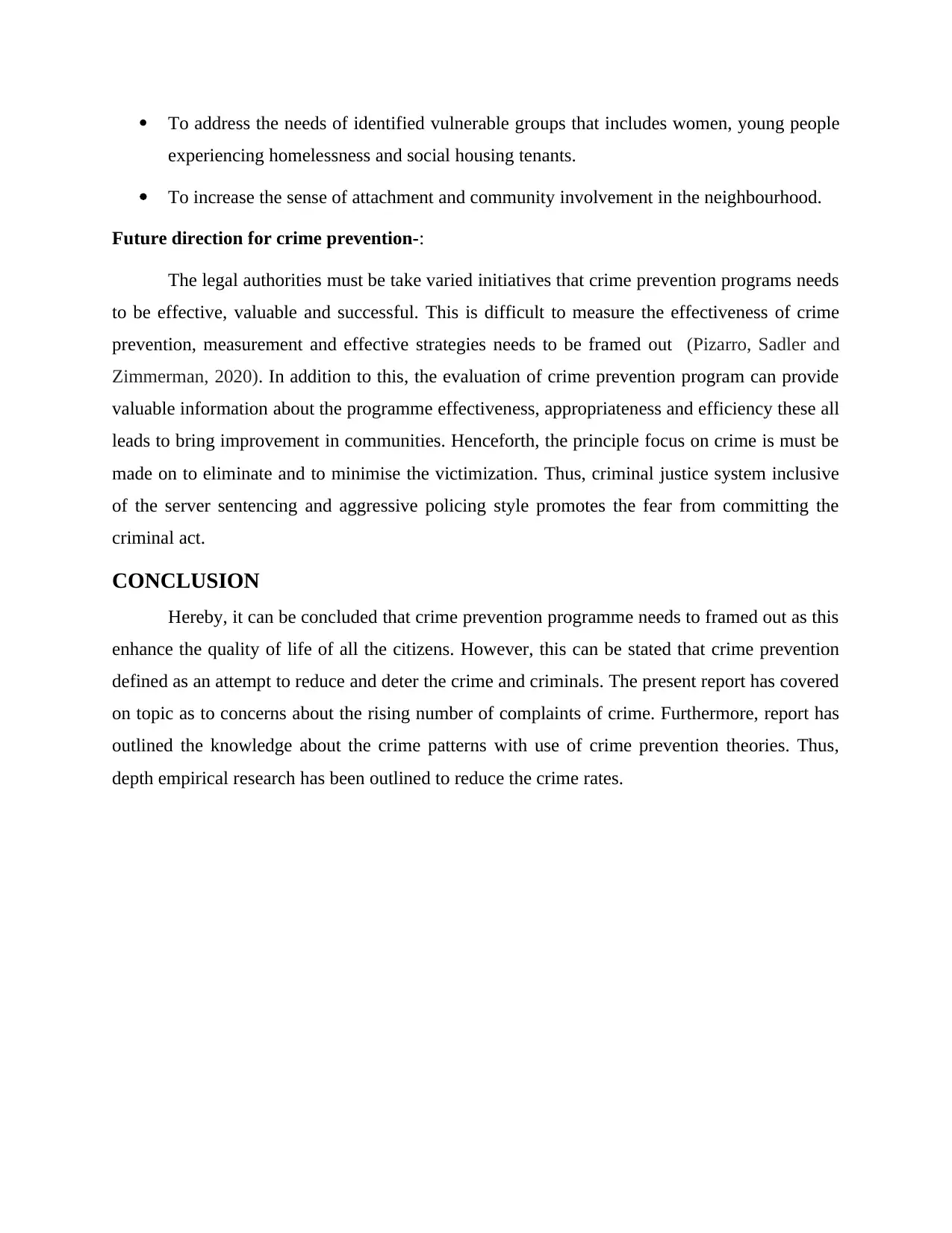
To address the needs of identified vulnerable groups that includes women, young people
experiencing homelessness and social housing tenants.
To increase the sense of attachment and community involvement in the neighbourhood.
Future direction for crime prevention-:
The legal authorities must be take varied initiatives that crime prevention programs needs
to be effective, valuable and successful. This is difficult to measure the effectiveness of crime
prevention, measurement and effective strategies needs to be framed out (Pizarro, Sadler and
Zimmerman, 2020). In addition to this, the evaluation of crime prevention program can provide
valuable information about the programme effectiveness, appropriateness and efficiency these all
leads to bring improvement in communities. Henceforth, the principle focus on crime is must be
made on to eliminate and to minimise the victimization. Thus, criminal justice system inclusive
of the server sentencing and aggressive policing style promotes the fear from committing the
criminal act.
CONCLUSION
Hereby, it can be concluded that crime prevention programme needs to framed out as this
enhance the quality of life of all the citizens. However, this can be stated that crime prevention
defined as an attempt to reduce and deter the crime and criminals. The present report has covered
on topic as to concerns about the rising number of complaints of crime. Furthermore, report has
outlined the knowledge about the crime patterns with use of crime prevention theories. Thus,
depth empirical research has been outlined to reduce the crime rates.
experiencing homelessness and social housing tenants.
To increase the sense of attachment and community involvement in the neighbourhood.
Future direction for crime prevention-:
The legal authorities must be take varied initiatives that crime prevention programs needs
to be effective, valuable and successful. This is difficult to measure the effectiveness of crime
prevention, measurement and effective strategies needs to be framed out (Pizarro, Sadler and
Zimmerman, 2020). In addition to this, the evaluation of crime prevention program can provide
valuable information about the programme effectiveness, appropriateness and efficiency these all
leads to bring improvement in communities. Henceforth, the principle focus on crime is must be
made on to eliminate and to minimise the victimization. Thus, criminal justice system inclusive
of the server sentencing and aggressive policing style promotes the fear from committing the
criminal act.
CONCLUSION
Hereby, it can be concluded that crime prevention programme needs to framed out as this
enhance the quality of life of all the citizens. However, this can be stated that crime prevention
defined as an attempt to reduce and deter the crime and criminals. The present report has covered
on topic as to concerns about the rising number of complaints of crime. Furthermore, report has
outlined the knowledge about the crime patterns with use of crime prevention theories. Thus,
depth empirical research has been outlined to reduce the crime rates.
Paraphrase This Document
Need a fresh take? Get an instant paraphrase of this document with our AI Paraphraser
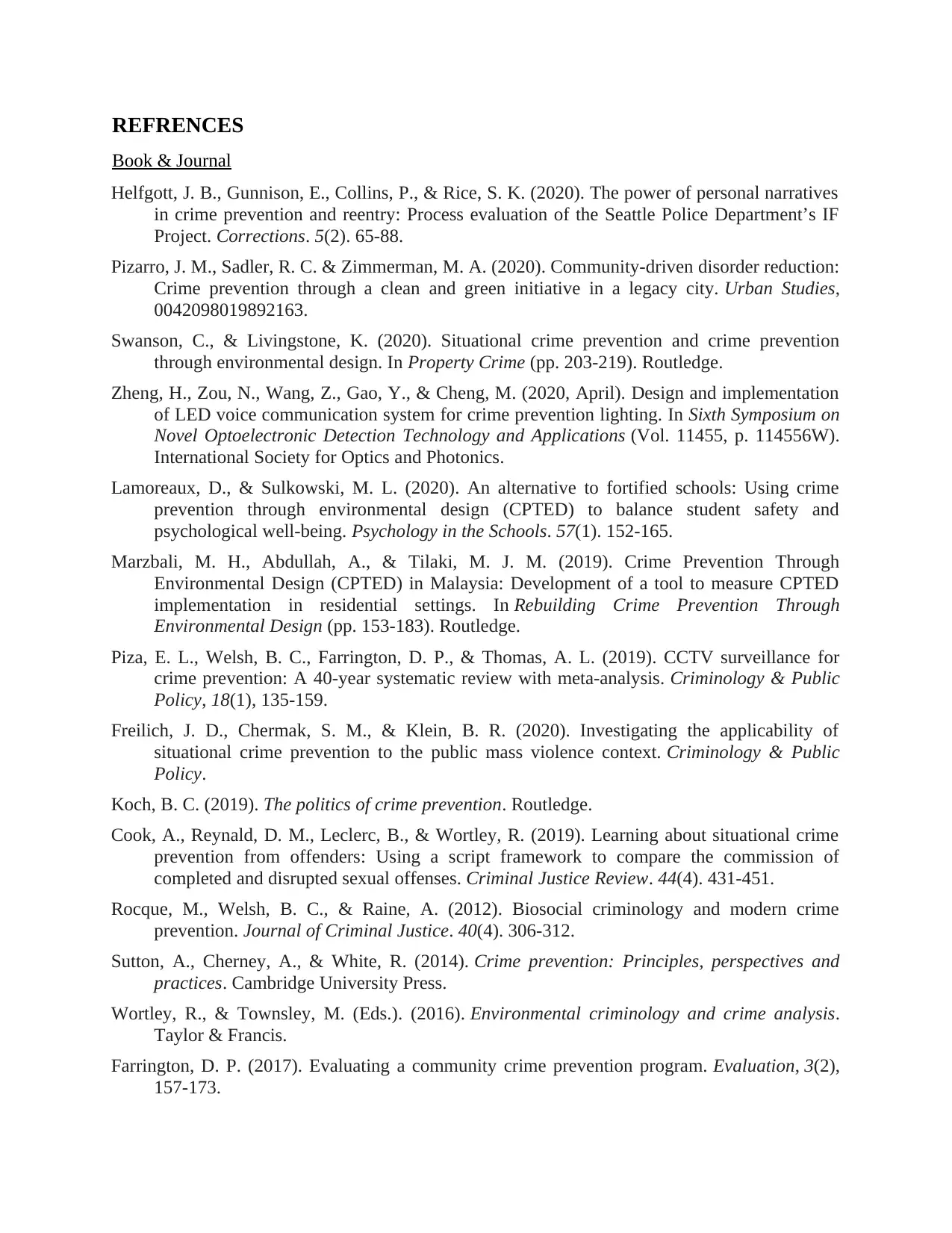
REFRENCES
Book & Journal
Helfgott, J. B., Gunnison, E., Collins, P., & Rice, S. K. (2020). The power of personal narratives
in crime prevention and reentry: Process evaluation of the Seattle Police Department’s IF
Project. Corrections. 5(2). 65-88.
Pizarro, J. M., Sadler, R. C. & Zimmerman, M. A. (2020). Community-driven disorder reduction:
Crime prevention through a clean and green initiative in a legacy city. Urban Studies,
0042098019892163.
Swanson, C., & Livingstone, K. (2020). Situational crime prevention and crime prevention
through environmental design. In Property Crime (pp. 203-219). Routledge.
Zheng, H., Zou, N., Wang, Z., Gao, Y., & Cheng, M. (2020, April). Design and implementation
of LED voice communication system for crime prevention lighting. In Sixth Symposium on
Novel Optoelectronic Detection Technology and Applications (Vol. 11455, p. 114556W).
International Society for Optics and Photonics.
Lamoreaux, D., & Sulkowski, M. L. (2020). An alternative to fortified schools: Using crime
prevention through environmental design (CPTED) to balance student safety and
psychological well‐being. Psychology in the Schools. 57(1). 152-165.
Marzbali, M. H., Abdullah, A., & Tilaki, M. J. M. (2019). Crime Prevention Through
Environmental Design (CPTED) in Malaysia: Development of a tool to measure CPTED
implementation in residential settings. In Rebuilding Crime Prevention Through
Environmental Design (pp. 153-183). Routledge.
Piza, E. L., Welsh, B. C., Farrington, D. P., & Thomas, A. L. (2019). CCTV surveillance for
crime prevention: A 40‐year systematic review with meta‐analysis. Criminology & Public
Policy, 18(1), 135-159.
Freilich, J. D., Chermak, S. M., & Klein, B. R. (2020). Investigating the applicability of
situational crime prevention to the public mass violence context. Criminology & Public
Policy.
Koch, B. C. (2019). The politics of crime prevention. Routledge.
Cook, A., Reynald, D. M., Leclerc, B., & Wortley, R. (2019). Learning about situational crime
prevention from offenders: Using a script framework to compare the commission of
completed and disrupted sexual offenses. Criminal Justice Review. 44(4). 431-451.
Rocque, M., Welsh, B. C., & Raine, A. (2012). Biosocial criminology and modern crime
prevention. Journal of Criminal Justice. 40(4). 306-312.
Sutton, A., Cherney, A., & White, R. (2014). Crime prevention: Principles, perspectives and
practices. Cambridge University Press.
Wortley, R., & Townsley, M. (Eds.). (2016). Environmental criminology and crime analysis.
Taylor & Francis.
Farrington, D. P. (2017). Evaluating a community crime prevention program. Evaluation, 3(2),
157-173.
Book & Journal
Helfgott, J. B., Gunnison, E., Collins, P., & Rice, S. K. (2020). The power of personal narratives
in crime prevention and reentry: Process evaluation of the Seattle Police Department’s IF
Project. Corrections. 5(2). 65-88.
Pizarro, J. M., Sadler, R. C. & Zimmerman, M. A. (2020). Community-driven disorder reduction:
Crime prevention through a clean and green initiative in a legacy city. Urban Studies,
0042098019892163.
Swanson, C., & Livingstone, K. (2020). Situational crime prevention and crime prevention
through environmental design. In Property Crime (pp. 203-219). Routledge.
Zheng, H., Zou, N., Wang, Z., Gao, Y., & Cheng, M. (2020, April). Design and implementation
of LED voice communication system for crime prevention lighting. In Sixth Symposium on
Novel Optoelectronic Detection Technology and Applications (Vol. 11455, p. 114556W).
International Society for Optics and Photonics.
Lamoreaux, D., & Sulkowski, M. L. (2020). An alternative to fortified schools: Using crime
prevention through environmental design (CPTED) to balance student safety and
psychological well‐being. Psychology in the Schools. 57(1). 152-165.
Marzbali, M. H., Abdullah, A., & Tilaki, M. J. M. (2019). Crime Prevention Through
Environmental Design (CPTED) in Malaysia: Development of a tool to measure CPTED
implementation in residential settings. In Rebuilding Crime Prevention Through
Environmental Design (pp. 153-183). Routledge.
Piza, E. L., Welsh, B. C., Farrington, D. P., & Thomas, A. L. (2019). CCTV surveillance for
crime prevention: A 40‐year systematic review with meta‐analysis. Criminology & Public
Policy, 18(1), 135-159.
Freilich, J. D., Chermak, S. M., & Klein, B. R. (2020). Investigating the applicability of
situational crime prevention to the public mass violence context. Criminology & Public
Policy.
Koch, B. C. (2019). The politics of crime prevention. Routledge.
Cook, A., Reynald, D. M., Leclerc, B., & Wortley, R. (2019). Learning about situational crime
prevention from offenders: Using a script framework to compare the commission of
completed and disrupted sexual offenses. Criminal Justice Review. 44(4). 431-451.
Rocque, M., Welsh, B. C., & Raine, A. (2012). Biosocial criminology and modern crime
prevention. Journal of Criminal Justice. 40(4). 306-312.
Sutton, A., Cherney, A., & White, R. (2014). Crime prevention: Principles, perspectives and
practices. Cambridge University Press.
Wortley, R., & Townsley, M. (Eds.). (2016). Environmental criminology and crime analysis.
Taylor & Francis.
Farrington, D. P. (2017). Evaluating a community crime prevention program. Evaluation, 3(2),
157-173.

McGarrell, E. F. (2020). Cascades: war, crime, peace, and crime prevention: reaction
essay. International Journal of Comparative and Applied Criminal Justice, 1-9.
essay. International Journal of Comparative and Applied Criminal Justice, 1-9.
⊘ This is a preview!⊘
Do you want full access?
Subscribe today to unlock all pages.

Trusted by 1+ million students worldwide
1 out of 9
Related Documents
Your All-in-One AI-Powered Toolkit for Academic Success.
+13062052269
info@desklib.com
Available 24*7 on WhatsApp / Email
![[object Object]](/_next/static/media/star-bottom.7253800d.svg)
Unlock your academic potential
Copyright © 2020–2025 A2Z Services. All Rights Reserved. Developed and managed by ZUCOL.





